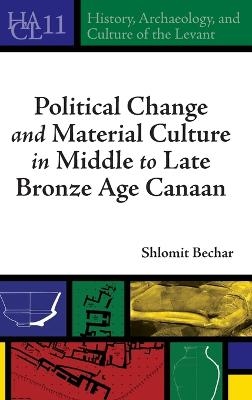
Political Change and Material Culture in Middle to Late Bronze Age Canaan
Eisenbrauns (Verlag)
978-1-64602-193-2 (ISBN)
Combining archaeological and historical analysis, Bechar identifies the most significant changes evident in architectural and ceramic remains from this period and then explores how and why contemporary political shifts may have influenced, or been influenced by, these developments. Bechar persuasively argues that the Egyptian conquest of the southern Levant—enabled by local economic decline following the expulsion of the Hyksos and the fall of northern Syrian cities—was the impetus for these changes in ceramics and architecture. Using a macro-typological approach to examine the ceramic assemblages, she also discusses the impact of the influx of Aegean imports, suggesting that while “attached specialists” were primarily responsible for ceramic production in the Middle Bronze Age, Late Bronze Age ceramics were increasingly made by “independent specialists,” another important result of the new administrative system created following Thutmose III’s campaign.
An important contribution to our understanding of the transition between the Middle and Late Bronze Ages, this original and insightful book will appeal to specialists in the Bronze Age Levant, especially those interested in using ceramic assemblages to examine social and political change.
Shlomit Bechar is Senior Lecturer at the School of Archaeology and Maritime Cultures. She is Codirector of the Tel Hazor excavations and is a coauthor of Hazor VII and Hazor VIII.
List of Illustrations
List of Tables
Acknowledgements
Chapter 1. Introduction
1.1 General Introduction
1.2 Research Questions and Aims of Study
1.3 Geographical Framework
1.4 Chronological Framework
1.5 Historical Background: The Sixteenth-Fourteenth Centuries BCE in the Ancient Near East
1.6 State of Research
1.7 Economic Models and Pottery Production: Theoretical Framework
1.8 Economic Model for the Southern Levant
1.9 Methodology
1.10 Research Outline
Chapter 2. The Transition from the Middle to the Late Bronze Age: Architectural Aspects at Hazor
2.1 Background
2.2 The Architectural Evidence
2.3 The Built Environment of the Lower City
2.4 Crisis Architecture
2.5 Historical Implications
2.6 Conclusions
Chapter 3. The Middle Bronze Age-Late Bronze Age Transition in the Levant: Architectural Aspects
3.1 Introduction
3.2 The Southern Levant
3.3 Northern Levant: Lebanon
3.4 Northern Levant: Syria
3.5 Summary and Conclusions
Chapter 4. Pottery Assemblages from the Middle and Late Bronze Ages
4.1 Methodology
4.2 Typological Scheme
4.3 Discussion by Site
4.4 Discussion and Summary
Chapter 5. Discussion and Conclusions
5.1 Introduction and Summary of Previous Chapters
5.2 Historical Implications
5.3 Changes in Ceramic Traditions and Consumption
5.4 Final Conclusions—From a Superpower in the MBA to a Great Vassal in the LBA
Bibliography
Index
| Erscheinungsdatum | 13.07.2022 |
|---|---|
| Reihe/Serie | History, Archaeology, and Culture of the Levant |
| Zusatzinfo | 72 Charts; 48 Halftones, black and white |
| Sprache | englisch |
| Maße | 152 x 229 mm |
| Gewicht | 540 g |
| Themenwelt | Geisteswissenschaften ► Archäologie |
| Geschichte ► Allgemeine Geschichte ► Vor- und Frühgeschichte | |
| Geschichte ► Allgemeine Geschichte ► Altertum / Antike | |
| ISBN-10 | 1-64602-193-2 / 1646021932 |
| ISBN-13 | 978-1-64602-193-2 / 9781646021932 |
| Zustand | Neuware |
| Informationen gemäß Produktsicherheitsverordnung (GPSR) | |
| Haben Sie eine Frage zum Produkt? |
aus dem Bereich


